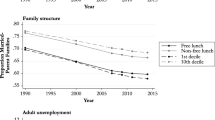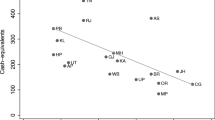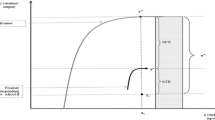Abstract
In this paper, we estimate a series of stochastic frontier cost functions for elementary schools, using a short panel of Texas data that allows us to account for student characteristics, input prices, environmental factors and student outcomes. Texas currently uses information about the share of students participating into the Free and Reduced Price Lunch (FRL) program to determine compensatory funding to provide to schools. The FRL measure has been criticized as a relatively poor measure of need. We consider a new, recently developed, measure of poverty, the Spatially Interpolated Demographic and Economic (SIDE) measure, as a possible complement or alternative to the FRL measure. SIDE uses the income of the neighborhood in which the school resides as the basis to assess need and poverty. We find that using both poverty metrics highlights the additional costs associated with serving high poverty populations in high poverty locations, i.e., neighborhood locations matter.





Similar content being viewed by others
Notes
See the Education Commission of the States, K-12 Funding: State Profiles. https://www.ecs.org/k-12-funding-state-profiles/.
Recently, the U.S. Census Bureau has calculated a Supplemental Poverty Measure. The new measure uses actual expenditures on food, clothing, shelter and utilities to assess poverty, while also adjusting for geographic variation in housing cost and family size and composition. The measure is updated every 5 years. The supplemental poverty measure estimates the after-tax income and adds back the monetary value of in-kind benefits. While a substantial improvement on the federal poverty level, the supplemental poverty measure is only available at the state and national levels and, therefore, has not been used for poverty measurement in education at the district and/or school level.
Formula-eligible children are determined using “the estimated number of 5–17 year-olds in poverty at the district level, along with counts (determined by administrative records) of Temporary Assistance for Needy Families (TANF) participants, foster children, and neglected and delinquent children” (Snyder et al., 2018, p. 5).
The slight modification is that we have also included the cube of district enrollment as an independent variable.
All variables except those already expressed as percentages or percentage points are in natural logarithms.
We exclude from the analysis Alternative Education Accountability (AEA) campuses (e.g., juvenile justice campuses, disciplinary education campuses, residential campuses and all other alternative education campuses), because they are subject to different accountability requirements and may have different cost structures than the other campuses (TEA 2016). Virtual campuses and campuses that lack reliable data on student performance, such as elementary education campuses that serve no students in tested grades, or very small campuses, are also excluded.
Fiscal agents collect funds from member districts in a shared service agreement, and make purchases or pay salaries with those shared funds on behalf of the member districts. As a result, the spending of fiscal agents is artificially inflated, while the spending by member districts is artificially suppressed. However, fiscal agents report annually to TEA the amounts they spent on behalf of their member districts. These data have been used to allocate spending by fiscal agents to their member districts on a proportional basis.
The equation used is: NCEjt = 50 + zjt*21.06, where zjt is the average of the individual standardized gain score for school j in year t.
The wage index is a weighted average of the Comparable Wage Index for Teachers (CWIFT) published by the NCES, the county fair market rents as published by the U.S. Department of Housing and Urban Development, the county unemployment rate as published by the U.S. Bureau of Labor statistics, the percentage of students who have ever been identified as English Language Learners and various measures of geographic isolation, climate, district type, and county type.
During the period under analysis, Texas used the percentage of economically disadvantaged students as state’s official school poverty metric. Texas defined economically disadvantaged students as those eligible for free or reduced-price lunch or eligible for other public assistance. The correlation between the percent economically disadvantaged and the percent free and reduced-price lunch according to the NCES was 0.993.
In Texas (as in other states), a student’s status regarding English proficiency is potentially an endogenous function of his or her academic performance. Therefore, rather than rely on the percentage of students who were currently identified as English Language Learners (ELL), Taylor et al. (2021) constructed a measure of student need that was clearly outside of school district control—the percentage of students in the district who had ever been considered ELL. Using data from the Education Research Center at the University of Texas at Dallas, they traced each student’s academic history to identify those students who had been ELL at some point during their experience in Texas schools. We thank them for sharing these data.
Following Gronberg et al. (2005), high needs special education students are those with a classification other than speech-language difficulties or learning disabilities. Where the share of students with speech-language difficulties or learning disabilities was censored (due to privacy concerns), the researchers presumed that all of the special education students were high needs students.
During the analysis period, Texas had a two-tier funding formula. The first tier is best characterized as a foundation plan, while the second tier is best characterized as a guaranteed yield with recapture. In both tiers, funding levels are weighted by indicators of student need, including the percentage of economically disadvantaged students. The funding formula weight for economically disadvantaged students is 20% higher than the baseline, all other things being equal.
We explored using an estimation strategy from Karakaplan (2022) to test for endogeneity. Unfortunately, that approach required us to reduce in an ad hoc manner the dimensionality of the translog specification used in our model, and ultimately could not be implemented.
We also explored other sets of potential instruments, such as the number of manufacturing establishments in the school’s zip code (from the ZIP Business Patterns produced by the Census Bureau), log square miles in the district, and a 5-year lag of the share of the county population who live in a city, town or other Census-designated place (which is a measure of population dispersion). These alternative instrument sets were also highly correlated with school size and quality in the first stage analysis and also supported the conclusion that we could not reject exogeneity. We chose the most parsimonious set of instruments for this report.
Note that Model 3 nests a SIDE version of Model 1, in which SIDE poverty impacts cost but not inefficiency. As Table 3 illustrates, the hypothesis that SIDE poverty’s impact on inefficiency is negligible is easily rejected.
References
Baker BD, Taylor LL, Vedlitz A (2008) Adequacy estimates and the implications of common standards for the cost of instruction. National Res Council 9(2):24–38
Baker BD, Taylor LL, Levin J, Chambers J, Blankenship C (2013) Adjusted poverty measures and the distribution of title I aid: Does title I really make the rich states richer? Educ Finance Policy 8(3):394–417
Barrow MM (1991) Measuring local education authority performance: a frontier approach. Econ Educ Rev 10(1):19–27
Bessent A, Bessent W, Kennington J, Reagan B (1982) An application of mathematical programming to assess managerial efficiency in the Houston independent school district. Manag Sci 28(12):1355–1367
Berne R, Stiefel L (1979) Taxpayer equity in school finance reform: The school finance and the public finance perspectives. J Educ Finance 5(1):36–54
Carpenter DM, Noller SL (2010) Measuring charter school efficiency: An early appraisal. J Educ Finance 35(4):497–415
Conroy SJ, Arguea NM (2008) An estimation of technical efficiency for Florida public elementary schools. Econ Educ Rev 27(6):655–663
Cooper ST, Cohn E (1997) Estimation of a frontier production function for the South Carolina educational process. Econ Educ Rev 16(3):313–327
de Witte K, López-Torres L (2017) Efficiency in education: a review of literature and a way forward. J Operational Res Soc 68(4):339–363
Domina T, Pharris-Ciurej N, Penner AM, Penner EK, Brummet Q, Porter SR, Sanabria T (2018) Is free and reduced-price lunch a valid measure of educational disadvantage? Educational Res 47(9):539–555
Duncombe W, Yinger J (2005) How much more does a disadvantaged student cost? Econ Educ Rev 24(5):513–532
Figlio DN, Winicki J (2005) Food for thought: the effects of school accountability plans on school nutrition. J Public Econ 89(2-3):381–394
Gleason P (2008) Direct certification in the national school lunch program expands access for children. J Assoc Public Policy Analysis Manag 27(1):82–103
Gleason P and Burghardt J (2005) The National School Lunch Program: Ensuring that Free and Reduced-Price Meal Benefits Go to the Poor. Mathematica Policy Research Inc. Issue Brief Number 2. https://www.mathematica.org/publications/the-national-school-lunch-program-ensuring-that-free-and-reducedprice-meal-benefits-go-to-the-poor
Geverdt D, Nixon L (2018). Sidestepping the Box: Designing a Supplemental Poverty Indicator for School Neighborhoods (NCES 2017-039). U.S. Department of Education. Washington, DC: National Center for Education Statistics. http://nces.ed.gov/pubsearch/.
Golebiewski JA (2011) An overview of the literature measuring education cost differentials. Peabody J Educ 86(1):84–112
Gronberg TJ, Jansen DW, Taylor LL, Booker KT (2004) School outcomes and school costs: The cost function approach. Texas A&M University, College Station, TX. https://bush.tamu.edu/wp-content/uploads/2020/08/SchoolOutcomesAndSchoolCosts.pdf
Gronberg TJ, Jansen DW, Taylor LL, Booker KT (2005) School outcomes and school costs: A technical supplement. Texas A&M University. College Station, TX. https://bush.tamu.edu/wp-content/uploads/2020/08/GJTBTechnicalSupplement4-8.pdf
Gronberg TJ, Jansen DW, Taylor LL (2011a) The adequacy of educational cost functions: Lessons from Texas. Peabody J Educ 86(1):3–27
Gronberg TJ, Jansen DW, Taylor LL (2011b) The impact of facilities on the cost of education. Natl Tax J 64(1):193–218
Gronberg TJ, Jansen DW, Taylor LL (2012) The relative efficiency of charter schools: A cost frontier approach. Econ Educ Rev 31(2):302–317
Gronberg TJ, Jansen DW, Karakaplan MU, Taylor LL (2015) School district consolidation: Market concentration and the scale‐efficiency tradeoff. Southern Econ J 82(2):580–597
Gronberg TJ, Jansen DW, Taylor LL (2017) Are charters the best alternative? A cost frontier analysis of alternative education campuses in Texas. Southern Econ J 83(3):721–743
Grosskopf S, Hayes K, Taylor LL, Weber WL (1997) Budget-constrained frontier measures of fiscal equality and efficiency in schooling. Rev Econ Statistics 79(1):116–124
Grosskopf S, Hayes K, Taylor LL, Weber WL (2018) Would weighted-student funding enhance intra-district equity in Texas? A simulation using DEA. J Operational Res Soc 68(4):377–389
Harwell M, LeBeau B (2010) Student eligibility for a free lunch as an SES measure in education research. Educational Res 39(2):120–131
Hauser RM (1994) Measuring socioeconomic status in studies of child development. Child Dev 65(6):1541–1545
Henderson DJ, Simar L, Wang L (2017) The three Is of public schools: irrelevant inputs, insufficient resources and inefficiency. Appl Econ 49(12):1164–1184
Hoxby CM, Kuziemko I (2004) Robin Hood and his not-so-merry plan: Capitalization and the self-destruction of Texas’ school finance equalization plan. NBER Working Papers 10722, National Bureau of Economic Research, Inc. https://doi.org/10.3386/w10722
Imazeki J, Reschovsky A (2004) Is No Child Left Behind an un (or under) funded federal mandate? Evidence from Texas. Natl Tax J 57(3):571–588
Karakaplan MU (2022) Panel stochastic frontier models with endogeneity. Stata J 22(3):643–663
Kurki A, Boyle A, Aladjem DK (2005) Beyond free lunch: Alternative poverty measures in educational research and program evaluation. American Institute For Research, paper prepared for the annual meeting of the American Educational Research Association, Montreal, Canada, April 11–15, 2005
Koedel C, Parsons E (2021) The Effect of the Community Eligibility Provision on the Ability of Free and Reduced-Price Meal Data to Identify Disadvantaged Students. Educational Eval Policy Analy 43(1):3–31. https://doi.org/10.3102/0162373720968550
Marks J, Isaacs J, Smeeding T, Thornton K (2010). Development of the Wisconsin Poverty Measure: Methods and findings for 2008. www.irp.wisc.edu/research/povmeas/ASA_SPM_WIPOV_2010.pdf. Accessed 13 March 2013.
National Center for Education Statistics. (n.d.). Comparable Wage Index for Teachers (CWIFT) [Data file]. https://nces.ed.gov/programs/edge/Economic/TeacherWage
National Center for Education Statistics. (n.d.). School neighborhood poverty [Data file]. https://nces.ed.gov/programs/edge/Economic/NeighborhoodPoverty
Owens A (2020) Unequal opportunity: school and Neighborhood segregation in the USA. Race Social Prob 12:29–41
Owens A, Candipan J (2019) Social and spatial inequalities of educational opportunity: A portrait of schools serving high- and low-income neighborhoods in US metropolitan areas. Urban Studies 56(15):3178–3197
Owens A, Reardon SF, Jencks C (2016) Income segregation between schools and school districts. Am Education Res J 53(4):1159–1197
Reback R (2008) Teaching to the rating: School accountability and the distribution of student achievement. J Public Econ 92(5–6):1394–1415
Renwick T (2009) Alternative Geographic Adjustments of U.S. Poverty Thresholds: Impact on State Poverty Rate. U.S. Census Bureau Working Paper. https://www.census.gov/content/dam/Census/library/working-papers/2009/demo/geo-adj-pov-thld8.pdf
Renwick T (2011) Geographic adjustments of supplemental poverty measure thresholds: Using the American Community Survey five-year data on housing costs. U.S. Census Bureau SEHSD Working Paper Number 2011-21. https://www.census.gov/content/dam/Census/library/working-papers/2011/demo/SEHSD-WP2011-21.pdf
Ruggles P (1990) Drawing the line: Alternative poverty measures and their implications for public policy. Urban Press Institute, Washington, DC
Short KS (2011) The research supplemental poverty measure. In 2010, Current Population Reports P60241, Census Bureau
Snyder T, Dinkes R, Sonnenberg W, Cornman S (2018) Study of the Title I, Part A Grant Program Mathematical Formulas (2019-016). U.S. Department of Education. National Center for Education Statistics, Washington, DC, Retrieved [04/18/2021] from http://nces.ed.gov/pubsearch
StataCorp (2021) Stata: Release 17. Statistical Software. StataCorp LLC, College Station, TX
Taylor LL, Grosskopf S, Hayes KJ (2014) Applied Efficiency Analysis in Education. Econ Business Lett 3(1):19–26
Taylor LL and Dar J (2015) Fairer trade, removing gender bias in US import taxes. Mosbacher Institute for Trade, Economics & Public Policy. https://hdl.handle.net/1969.1/153774
Taylor LL, Gronberg TJ, Jansen DW and Bartlett CS (2021) A Study on Geographic Education Cost Variations and School District Transportation Costs. https://tea.texas.gov/sites/default/files/hb3-transportation-report.pdf
Texas Education Agency (2016) 2016 Accountability manual. Retrieved December 30, 2022 from https://tea.texas.gov/sites/default/files/2016%20Accountability%20Manual-Full_Final.pdf
Acknowledgements
We thank participants to the Southern Economic Association annual 2021 meeting, the Western Economic Association annual 2022 meeting and to the EWEPA 2022 meetings.
Author information
Authors and Affiliations
Corresponding author
Ethics declarations
Conflict of interest
The authors declare no competing interests.
Additional information
Publisher’s note Springer Nature remains neutral with regard to jurisdictional claims in published maps and institutional affiliations.
Rights and permissions
Springer Nature or its licensor (e.g. a society or other partner) holds exclusive rights to this article under a publishing agreement with the author(s) or other rightsholder(s); author self-archiving of the accepted manuscript version of this article is solely governed by the terms of such publishing agreement and applicable law.
About this article
Cite this article
Taylor, L., Grosskopf, S., Hayes, K. et al. The role of poverty measurements in achieving educational equity through school finance reform. J Prod Anal 60, 109–127 (2023). https://doi.org/10.1007/s11123-022-00657-w
Accepted:
Published:
Issue Date:
DOI: https://doi.org/10.1007/s11123-022-00657-w




